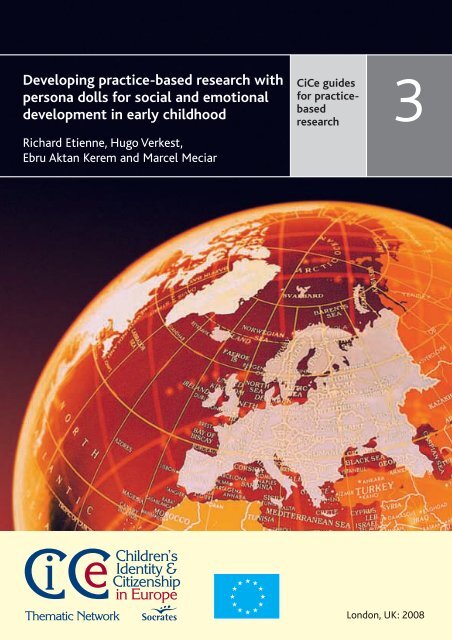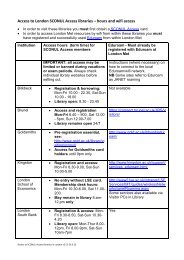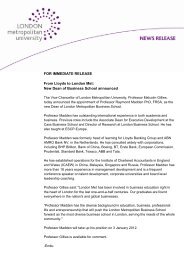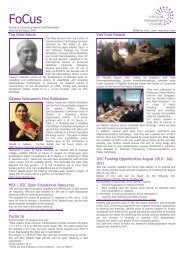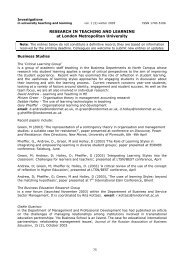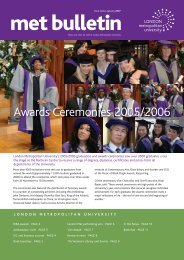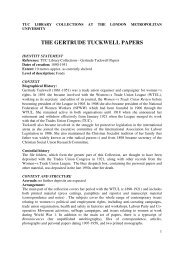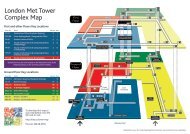Developing practice-based research with persona dolls for
Developing practice-based research with persona dolls for
Developing practice-based research with persona dolls for
You also want an ePaper? Increase the reach of your titles
YUMPU automatically turns print PDFs into web optimized ePapers that Google loves.
<strong>Developing</strong> <strong>practice</strong>-<strong>based</strong> <strong>research</strong> <strong>with</strong><br />
<strong>persona</strong> <strong>dolls</strong> <strong>for</strong> social and emotional<br />
development in early childhood<br />
Richard Etienne, Hugo Verkest,<br />
Ebru Aktan Kerem and Marcel Meciar<br />
iCCe<br />
CiCe guides<br />
<strong>for</strong> <strong>practice</strong><strong>based</strong><br />
<strong>research</strong><br />
3<br />
London, UK: 2008
This Guide has been written and prepared by the CiCe Network’s Working Group on Practice-<br />
Based <strong>research</strong>:<br />
Richard Etienne is a <strong>research</strong>er and professor at the university Montpellier III (France). He studies<br />
procedures of change in education and teacher training. He works on special needs in education<br />
and on project management in schools. As the head of education department in France he had to<br />
set up a branch of training in special needs education.<br />
Hugo Verkest is a lecturer at both the School of Education (campus Torhout) of Katholieke<br />
Hogeschool Zuid- West- Vlaanderen (KATHO-RENO) and at the Higher Episcopal Institute of<br />
Education (HIVO- Brugge). He is involved in an European module <strong>for</strong> trainer training in the<br />
Pestalozzi Programme of the Council of Europe. For CiCe he is the national co-ordinator <strong>for</strong><br />
Belgium.<br />
Ebru Aktan Kerem is Assistant Professor of Department of Elementary Education, Programme of<br />
Early Childhood Education at Çanakkale Onsekiz Mart University (Turkey). She is Educational<br />
Advisor to Children House (Preschool Education Centre) <strong>based</strong> at the university. She has published<br />
on early literacy development, phonological awareness in the early years, peace education (antibias<br />
and conflict resolution) and comparative models of early childhood education.<br />
Marcel Meciar is a <strong>research</strong>er and lecturer at the University of Ostrava (Czech Republic). He is<br />
interested in the study of social identities (regional identity, identity of immigrants, pupils’<br />
identities). On the pedagogical field, he works as a member of the Department of Social Sciences<br />
at the Pedagogical Faculty on “a translation” of scientific knowledge concentrating on the <strong>for</strong>m<br />
that would be useful <strong>for</strong> teachers of Civic Education on the level of elementary schools.<br />
Special thanks to:<br />
The staff, the teachers (especially Duygu Acar), support staff and the student assistants at<br />
Canakkale Onsekiz Mart University Cocuklar Evi<br />
Dr. Isik Kamaraj, Marmara University Ataturk Faculty of Education Department of Elementary<br />
Education<br />
Series editor: Alistair Ross, International Coordinator, CiCe<br />
This report does not necessarily represent the views of the CiCe Network.<br />
This project has been funded <strong>with</strong> support from the European<br />
Commission. This publication reflects the views only of the authors,<br />
and the Commission cannot be held responsible <strong>for</strong> any use which<br />
may be made of the in<strong>for</strong>mation contained herein.<br />
CiCe guides <strong>for</strong> <strong>practice</strong>-<strong>based</strong> <strong>research</strong>:<br />
<strong>Developing</strong> <strong>practice</strong>-<strong>based</strong> <strong>research</strong> <strong>with</strong> <strong>persona</strong> <strong>dolls</strong> <strong>for</strong> social and emotional development in<br />
early childhood<br />
ISBN: 978-0-9560454-3-0<br />
CiCe Guidelines: ISSN 1741-6353<br />
September 2008<br />
CiCe Central Coordination Unit<br />
Institute <strong>for</strong> Policy Studies in Education<br />
London Metropolitan University<br />
166 – 220 Holloway Road<br />
London N7 8DB<br />
UK<br />
This publication is also available in electronic <strong>for</strong>mat at http://cice.londonmet.ac.uk
<strong>Developing</strong> <strong>practice</strong>-<strong>based</strong> <strong>research</strong> <strong>with</strong><br />
<strong>persona</strong> <strong>dolls</strong> <strong>for</strong> social and emotional<br />
development in early childhood<br />
Richard Etienne, Hugo Verkest,<br />
Ebru Aktan Kerem and Marcel Meciar
Contents<br />
Introduction 1<br />
<strong>Developing</strong> a culture of <strong>research</strong> inside the classroom 2<br />
The backpack of a <strong>practice</strong> –<strong>based</strong> <strong>research</strong>er 3<br />
The knowledge component: Enough food <strong>for</strong> the <strong>practice</strong>? 3<br />
The emotional component: do you need a handkerchief? 3<br />
The narrative component: a notebook or a diary? 5<br />
Ethical and attitudinal component: Is a compass necessary? 5<br />
Inquiry component: use a magnifying glass! 7<br />
The visual component: don’t <strong>for</strong>get your camera! 7<br />
The action component: becoming a coach 8<br />
Persona <strong>dolls</strong>, a tool <strong>for</strong> knowledge and emotions...? 9<br />
Dolls in an educational world 9<br />
The founding Mothers of Persona Dolls 10<br />
The preparation and the stages of the application 11<br />
General and specific features of Persona Dolls 12<br />
Reflections about the Persona Dolls in action 13<br />
Conclusions 16<br />
References 17<br />
Appendices 19
<strong>Developing</strong> Practice-Based Research 1<br />
Introduction<br />
This is the third in our series of guidelines that focus on developing<br />
<strong>practice</strong>-<strong>based</strong> <strong>research</strong>. In 2006 we focused on co-operative<br />
learning, teaching and school counselling. Philosophy <strong>with</strong> children in<br />
relation to critical thinking was the topic in 2007. These guidelines<br />
are the outcome of our talks and workshops on creative teaching,<br />
emotional and intercultural learning <strong>with</strong> the medium of ‘Persona<br />
Dolls’. All the visual material of our three-year project is collected on<br />
the CD-ROM, and we hope it will be useful in courses of higher<br />
education, and that it will stimulate colleagues to undertake<br />
<strong>practice</strong>-<strong>based</strong> <strong>research</strong> <strong>with</strong> their students and <strong>with</strong> educational<br />
fieldworkers.<br />
We begin <strong>with</strong> the metaphor of a backpack to indicate the key<br />
components that are necessary to organise <strong>practice</strong>-<strong>based</strong> <strong>research</strong><br />
<strong>with</strong>in an educational environment. In addition we present the<br />
application of our workshop and some reflections. The latter is<br />
always necessary to do <strong>practice</strong>-<strong>based</strong> <strong>research</strong>.
2<br />
<strong>Developing</strong> a culture of <strong>research</strong> inside the classroom<br />
<strong>Developing</strong> Practice-Based Research<br />
There are many important things we learn from <strong>research</strong>. There are<br />
also a number of important things to be said about <strong>research</strong>. We talk<br />
here about <strong>research</strong> as it is related to the <strong>practice</strong> of the teachers.<br />
This is not <strong>research</strong> about teachers, but rather, it is about teachers<br />
doing <strong>research</strong>.<br />
Teachers have the skills and the ability to bring out the best in<br />
young, developing minds and hearts. Much of this takes place behind<br />
closed doors, and is often insufficiently shared or observed by peers.<br />
Teachers can learn from what they see in the classrooms of their<br />
peers and improve or change their own professional skills by<br />
observing and incorporating new per<strong>for</strong>mance into their <strong>practice</strong>, and<br />
new strategies into their mindsets, <strong>for</strong> their own benefit and that of<br />
the whole learning community.<br />
Teachers have much to learn from each other and from their<br />
educational environments: teacher <strong>research</strong> is an ideal way of<br />
investigating these environments.<br />
‘What is going on?’ is the most fundamental <strong>research</strong> question that<br />
generates sub–sets of questions in teachers’ minds on topics<br />
meaningful to them. Another question <strong>for</strong> a <strong>practice</strong>–<strong>based</strong><br />
<strong>research</strong>er is ‘do I like what I get?’<br />
The <strong>research</strong> done by teachers can become a driving <strong>for</strong>ce <strong>for</strong><br />
educational change and school development, in various and humble<br />
ways. Doing <strong>practice</strong> or practitioner–<strong>based</strong> <strong>research</strong> is no longer the<br />
privilege of a special group of people called <strong>research</strong>ers but, given<br />
certain conditions, available <strong>for</strong> any practitioner to do as a part of<br />
everyday <strong>practice</strong> (Bryant 1997).<br />
Teachers are no strangers to data. In fact they are the generators,<br />
collectors and receivers of substantial amounts of data derived from<br />
the day-to-day learning outcomes of their pupils. Where teachers<br />
may need support is in analysing these data <strong>for</strong> their findings.<br />
However the skills of objective interpretation are, <strong>with</strong> an open mind,<br />
readily learnable. They are underpinned by reflexivity as Schön<br />
asserts in his concept of professionals as ‘reflective practitioners’<br />
(Schön 1983).
<strong>Developing</strong> Practice-Based Research 3<br />
The backpack of a <strong>practice</strong> –<strong>based</strong> <strong>research</strong>er<br />
The knowledge-component : Enough food <strong>for</strong> <strong>practice</strong> ?<br />
The French philosopher Jean–François Lyotard identifies in the<br />
Postmodern Condition: A Report on Knowledge (1984) two types of<br />
knowledge : scientific (logos) and narrative (mythos). Knowledge in<br />
general cannot be reduced to science, nor even to learning. Learning<br />
is the set of statements which, to the exclusion of all other<br />
statements, denote or describe objects and may be declared true or<br />
false. Knowledge includes notions of ‘know–how’ (savoir–faire),<br />
‘knowing how to live’ (savoir–vivre), ‘how to listen’ (savoir-entendre).<br />
Lyotard’s ideas allow us to include under the umbrella of knowledge<br />
the stories that are told in order to cement the social bond between<br />
children, and which bind them together by their three-fold<br />
competence in the speech acts of ‘know–how’, knowing how to<br />
speak and knowing how to listen – through which the community’s<br />
relationship to itself and its environment is played out. He wanted to<br />
promote the competence to have ‘good’ per<strong>for</strong>mances. This capacity<br />
to communicate and live <strong>with</strong> justice, beauty, truth and efficiency<br />
goes beyond scientific knowledge. It is a knowledge that is <strong>for</strong>med by<br />
shared and passed-on narratives (Colpaert 2007).<br />
The development of knowledge is the goal of an inquiry. In<br />
<strong>practice</strong>–<strong>based</strong> <strong>research</strong> we try various ways of looking at<br />
experience, continually reinterpreting experience into workable<br />
principles and concepts.<br />
The emotional component: Do you need a handkerchief?<br />
To call a teacher ‘emotionally literate’ assuredly still requires inverted<br />
commas, despite the enormous success of Howard Gardner (Gardner<br />
1983,1993) and Daniel Goleman (Goleman 1995, 1998), whose<br />
<strong>research</strong> and writing figure widely in so much current thinking.<br />
Gardner makes a tentative but compelling case <strong>for</strong> the theory of<br />
multiple intelligences, arguing that the commonly measured<br />
cognitive human capacities give an inadequate picture of the<br />
qualitatively different ways in which humans can show ‘intelligence’.<br />
For Gardner, the inter- and intra-<strong>persona</strong>l intelligences – knowing and<br />
relating well to yourself and <strong>for</strong>ming good relationships <strong>with</strong> others<br />
– represent two strands of a single intelligence quite independent of<br />
other intelligences such as linguistic or mathematical capacity.<br />
Goleman expands Gardner’s somewhat cognitively constrained fields<br />
to include the affective dimension. For him we need to bring<br />
intelligence to emotion, some thinking into our feeling. Salovey and<br />
Sluyter (1997) introduced the term ‘emotional literacy’ and were<br />
pioneers in that field. They mapped ‘emotional intelligences’ in five<br />
main domains:
4<br />
<strong>Developing</strong> Practice-Based Research<br />
1. Knowing one’s emotions: being self–aware<br />
2. Managing emotions: handling feelings in a way that is<br />
appropriate<br />
3. Motivating oneself: stifling impulsiveness, delaying gratification,<br />
being able to get into the ‘flow state’ that characterizes<br />
productive and effective people<br />
4. Recognizing emotions in others: empathy<br />
5. Handling relationships.<br />
For teachers as <strong>research</strong>ers, simply to have a name to attach to the<br />
feeling they are experiencing in relation to the children gives them<br />
some foothold, some point of reference and even some rest. The<br />
children need positive commitments to both moral rules and to the<br />
well-being of their fellows. Teachers and caregivers in early childhood<br />
may look <strong>for</strong> ‘tools’, so that moral development is not stagnant in<br />
the early developmental stage. A young child must acquire the<br />
disposition to feel sympathy. This insight makes us aware of the<br />
utmost importance of early childhood (moral) education.<br />
Exploring the potential of sentiments of compassion of the children<br />
might influence teachers’ thoughts, feelings and behaviour. Martha<br />
Nussbaum (2001) as moral philosopher invites us to focus our<br />
attention on the ways in which people may be ‘morally educated’ in<br />
their imagination of suffering, thus acquiring a greater concern <strong>for</strong><br />
social justice. Nussbaum proposes that it may only be on the basis<br />
of a ‘compassionate training of the imagination’, which involves<br />
devoting time and space to reflecting upon literary and artistic<br />
representations of what suffering does to children and teachers, that<br />
it is possible to develop educational applications that uphold<br />
principles of civic virtues.<br />
Teachers asked <strong>for</strong> a sensitive language to pronounce the sensitive.<br />
Catherine Meyor describes her approach:<br />
la parole sensible autorise la pause de goûter le monde, de<br />
sentir d’être différent les choses, d’éprouver la justesse du mot.<br />
Elle est un territoire ouvert sur la diversité du réel, conciliant<br />
les ambivalences, incluant les oppositions. Elle diffère du<br />
langage conceptuel qui embrigade en limitant, qui pose en<br />
éliminant, qui définit en excluant<br />
[A sensitive expression (la parole sensible) enables one to<br />
appreciate a taste of the world, to feel that you differentiate<br />
things, to experience the accuracy of the word. It is an opening<br />
on to the diversity of reality that reconciles ambivalences,<br />
encompasses the opposites. It differs from conceptual<br />
expression that enrolls and limits at the same time, that rules<br />
out so as to establish control, that defines by excluding.]<br />
(Meyor, 2002 p 228)
<strong>Developing</strong> Practice-Based Research 5<br />
The narrative component : a notebook or a diary?<br />
Beattie (1995) argues that narrative ways of knowing can help<br />
teachers to both construct and reconstruct their <strong>persona</strong>l practical<br />
knowledge. Placing emphasis on teachers’ <strong>persona</strong>l and shared ways<br />
of knowing and on connecting the past, present and future are<br />
consistent <strong>with</strong> a key theme in this booklet. In our <strong>research</strong> we found<br />
that during the interviews we focussed on the motives and<br />
behaviour of pupils, and at the end they turned to themselves to find<br />
the same motives. The interviews have made sense of new<br />
‘revelations’ in ways that have validated their <strong>practice</strong>. One describes<br />
it as an ‘amazing process’ another a kind of sudden breakthrough, a<br />
so–called ‘ disclosure’.<br />
Social life is a narrative (MacIntyre 1981). Storytelling is an<br />
elementary <strong>for</strong>m of human communication. Narratives are the<br />
stories people tell to each other. People recall what happened<br />
through narratives and put experience into sequence. Storytelling<br />
helps to make familiar events and feelings of everyday life. Different<br />
communities tell their stories <strong>with</strong> words that have given meanings.<br />
Mother tells fairy tales to her children be<strong>for</strong>e sleep; kids tell their<br />
stories to classmates.<br />
There is an interesting debate in social science on the narrative that<br />
might be utilized in a pedagogical way – in this case in the context<br />
of multicultural value and emotional education. ‘Are stories lived or<br />
are merely told?’ Narrativism (a position between narrative realism<br />
and narrative constructivism) explains that the question is wrong. It<br />
is a false dichotomy: either lived, or told. Stories are lived because a<br />
human action has essentially a narrative nature and <strong>for</strong>m. We put a<br />
history <strong>with</strong> future together by agency (by our actions). But stories<br />
are also told because we can understand narrative patterns<br />
backwards. American philosopher Brian Fay (1996) suggests that ‘our<br />
lives are enstoried and our stories are enlived’.<br />
The narrative component in the <strong>persona</strong> <strong>dolls</strong> method, as we will<br />
show, is of great importance because it enables us to use both<br />
interconnected levels – fiction and reality, or past and present – to<br />
put life through a story.<br />
Practice–<strong>based</strong> <strong>research</strong>ers need the competence to tell or write<br />
their narratives. The difference between writing a story and telling a<br />
narrative is that the latter contains an evaluation of experiences<br />
linked <strong>with</strong> (innovated) scientific insights.<br />
The ethical and attitudinal component: is a compass necessary?<br />
Which kinds of ethical attitudes and considerations must a<br />
practitioner–<strong>based</strong> <strong>research</strong>er–teacher take into account? In ethics<br />
attitude is a technical term which means in essence being <strong>for</strong> or<br />
against something. If we are <strong>for</strong> peace, we have a positive attitude
6<br />
<strong>Developing</strong> Practice-Based Research<br />
towards it, and if we are against wars, we have a negative attitude<br />
towards them. For the Dutch moral educator Ben Spiecker (1999)<br />
holding an attitude towards something is the same as evaluating it,<br />
and from his point of view emotions are moral only if they are <strong>based</strong><br />
on (accepted) evaluations of others. The attitudes or evaluations of<br />
others are significant <strong>for</strong> a teacher-<strong>research</strong>er if she is capable of<br />
being affected by her conviction that they have these attitudes.<br />
These attitudes (or evaluations) are important as they are relevant<br />
independent of all conditions of these attitudes and the effects that<br />
they could have, like satisfaction or frustration.<br />
In the daily work of a teacher there is dominant perspective: to see<br />
things from the view of the pupils. It will be interesting to find<br />
whether it makes any difference to also see them as <strong>research</strong><br />
participants.<br />
Working <strong>with</strong> <strong>persona</strong> <strong>dolls</strong> <strong>with</strong> children (see below) can link to<br />
cornerstones of the ethics of relationships, namely responsibility,<br />
resilience, connectedness and trust (Dillen 2008). Responsibility<br />
precedes ethical choice and the concrete <strong>for</strong>m of any relationship or<br />
engagement: people can decide to take up the responsibility or not.<br />
Responsibility refers to the ethical appeal of the other. The<br />
responsibility comes from outside, in the sense that it does not arise<br />
from nature or a complex of ethical norms given to an individual to<br />
be internalised but from the cry of the victims of social exclusion.<br />
Resilience refers to the potential of teachers to recover and to<br />
rebuild their lives after suffering or bad experiences of exclusion.<br />
People can show a high degree of resilience even in peculiar<br />
circumstances. The concept of resilience shows educators and their<br />
target groups not merely as passive victims, but also as active<br />
subjects. Resilience makes it possible not only to focus on what goes<br />
wrong in situations, or on irresponsible behaviour but also opens our<br />
eyes to a variety of stimulating possibilities.<br />
Responsibility and resilience are both ideas that <strong>for</strong>m a broader<br />
theoretical framework about relationships, a framework characterised<br />
by ‘connectedness’ (the original meaning of religion). Connectedness<br />
is a different <strong>for</strong>m of cohesion and does not mean that people have<br />
to do things together nor must stay together. But the idea of<br />
connectedness <strong>for</strong>ms the basis of faith in our need of each other,<br />
and that we should try to find solutions.<br />
Trust is the fourth main theme in this approach. One needs trust to<br />
prevent ethical or religious fanaticism and an excessively heavy<br />
burden of responsibility. These four cornerstones leave room <strong>for</strong><br />
interpretation and an ethical response to concrete situations.<br />
Elliott (1989) emphasised the importance of the ethical dimension in<br />
<strong>practice</strong>–<strong>based</strong> <strong>research</strong>. In <strong>practice</strong>, <strong>persona</strong>l values are realised in<br />
concrete <strong>for</strong>ms of action and this necessarily involves a continuous
<strong>Developing</strong> Practice-Based Research 7<br />
process of practitioner reflection. The realisation of value is<br />
ultimately a matter of <strong>persona</strong>l judgement in specific situations and<br />
is open to reinterpretation. In reflective <strong>practice</strong>, practitioners<br />
continually reinterpret their own beliefs and values in the process of<br />
reflection in and on action (Elliott 1989). In some cases <strong>practice</strong><strong>based</strong><br />
<strong>research</strong> is remedial <strong>research</strong> to retrace the balance in the<br />
explored and disturbed class community. Applications <strong>with</strong> Persona<br />
Dolls can be a useful tool <strong>for</strong> a <strong>practice</strong>–<strong>based</strong> <strong>research</strong>er.<br />
Inquiry component: use a magnifying glass!<br />
Inquiry is stimulated by confrontation <strong>with</strong> reality or <strong>with</strong> a problem.<br />
Knowledge results from the inquiry. Practice-<strong>based</strong> <strong>research</strong> is <strong>based</strong><br />
on an event on which an individual can react to or puzzle over – a<br />
problem to be solved. Practice <strong>based</strong> <strong>research</strong> is remedial <strong>research</strong>.<br />
Having identified and exposed bias or injustice in the classroom,<br />
teachers turn their attention to rectifying the imbalance. Means like<br />
Persona Dolls could be active agents <strong>for</strong> the cultivation of virtues<br />
and viewpoints in the world of the child. These educational toys<br />
were used to revisit previous events, that had either been omitted by<br />
children or assigned them stereotypical positions.<br />
One of the challenges of <strong>practice</strong>–<strong>based</strong> <strong>research</strong> is<br />
conceptualization. How can a <strong>practice</strong>–<strong>based</strong> <strong>research</strong>er<br />
conceptualise inquiry so that they recognise that knowledge is<br />
constrained by conditions confronted as external realities, not of our<br />
own making?<br />
The visual component: don’t <strong>for</strong>get your camera!<br />
Recording visual data helps to construct a greater awareness <strong>for</strong><br />
<strong>practice</strong>-<strong>based</strong> <strong>research</strong>. Educators and teachers must express their<br />
approaches, but also pupils and adults <strong>with</strong> disabilities require and<br />
deserve a <strong>for</strong>um where they can explain their problems, wishes and<br />
expertise.<br />
Focussing on the class community through the lens of the camera<br />
encourages and empowers the teacher, giving them self esteem, and<br />
others stimulation. Products are built on knowledge in action,<br />
through a holistic bottom-up approach. Indicators and issues of<br />
professional identity that contribute to innovatory <strong>practice</strong> must<br />
become everyday topics. We need to awaken the empathy and<br />
empowerment that will help counter cultures of ignorance. Visual<br />
data will not only illustrate the policy of a school (such as cooperative<br />
learning) but will also better in<strong>for</strong>m the wider community<br />
about how children react to new inputs and children’s own designs<br />
of the world of play and thought (Verkest 2007).<br />
This participatory approach generates contextualising or storytelling.<br />
Videos give voice to individual and collective experience. Schools
8<br />
need to draw on people’s knowledge to build capacity, through<br />
participation at local level, using local data to solve problems at<br />
ground level and through listening to and empowering local<br />
participation. Teachers become aware that solutions to their<br />
individual problems are met by the teaching staff and the school<br />
vision. This method enables people to define themselves and others:<br />
the most direct application of the visual approach. Participants in the<br />
videos have codified themes and patterns, or developed step by step<br />
views grounded in data.<br />
The action component: becoming a coach<br />
<strong>Developing</strong> Practice-Based Research<br />
Photographing ‘what a person does’ tends to reduce the action to<br />
what can be seen through a camera. Photographs usually do not give<br />
enough in<strong>for</strong>mation to understand what was taking place. Who else<br />
was involved, when and where did this happen, what were the<br />
expectations of doing/ not doing this, and what might have been the<br />
consequences over a shorter or longer period? All these questions<br />
(and more) refer to ‘circumstances’ – the elements that surround<br />
human art.<br />
To morally evaluate an action, the motivations <strong>for</strong> the act must be<br />
understood. Not recognising and dealing <strong>with</strong> the complexity of an<br />
action can reduce any description of the act to its components. A<br />
description that only refers to ‘what happened’ - the material,<br />
physically described action – differs from the intention of those<br />
engaged in the event: does the intention and attitude involved in<br />
decision-making ensure moral rectitude or integrity (Selling 2008)?<br />
Observers should be aware that their primary function is not to give<br />
‘expert advice’ to their colleagues in action, but to observe trainee<br />
teachers and observe the process to gain ideas <strong>for</strong> their own<br />
teaching. The teacher is the coach, in the sense that he or she is<br />
demonstrating a teaching episode. In teaching and being observed,<br />
the teacher becomes a coach.
<strong>Developing</strong> Practice-Based Research 9<br />
Persona <strong>dolls</strong>, a tool <strong>for</strong> knowledge and emotions?<br />
Dolls in an educational world<br />
Dolls are not just <strong>for</strong> the play corner or only meant <strong>for</strong> girls! They<br />
have deservedly had a place in classes <strong>for</strong> many decades, used by<br />
teachers as well as children. Increasingly <strong>dolls</strong> are used to function in<br />
the same way as puppets, but <strong>with</strong>out any strings.<br />
As a result of an educational visit to a Belgian toy museum, four<br />
students in the teacher training college introduced a class doll during<br />
their teaching <strong>practice</strong>. Reflecting on their <strong>practice</strong>, the students<br />
argued that ‘the <strong>dolls</strong> gave them extra security, extra ears and eyes’.<br />
They had the impression ‘not being alone in front of the pupils’ and<br />
‘that the doll was a partner, a supporter during their instructions’. To<br />
accompany the doll, the students often brought some extra effects: a<br />
basket, or a suitcase filled <strong>with</strong> small and attractive things to<br />
introduce new ideas and build a different environment.<br />
One student teacher gave her doll the symbolic name Fidelio, in<br />
order to improve the children’s self-confidence, and she <strong>practice</strong>d to<br />
move <strong>with</strong> the doll ‘Fidelio’ in a natural way. On one occasion she<br />
used Fidelio to listen to the children’s experiences after a class visit<br />
to the dentist. Fidelio was included in circle time. The doll<br />
accompanied the student in managing silent working time.<br />
Another teacher, Tom, used Barthel as an outdoor doll when he<br />
worked in a community school on the border between France and<br />
Belgium. Several pupils in the class come from French families and<br />
spoke French: this project stimulated children to reflect on their outof-school<br />
activities and to express their feelings, desires and their<br />
way of living. ‘Barthel’ was an acronym: each letter makes a point in<br />
Tom’s classroom.<br />
Barthel<br />
B (Beleefd): politeness to teachers, parents, pupils<br />
A (Aandachtig): giving attention to others, the school and<br />
to lessons<br />
R (Respect): <strong>for</strong> opinion, and <strong>for</strong> the work of other pupils<br />
T (Tolerant): tolerance to other<br />
H (Hulpvaardig): helpful to others, if you have the capacity<br />
E (Eerlijk): to be honest<br />
L (Lief): to be good to each other and to contribute to a good<br />
atmosphere<br />
Barthel became a mediator to create a great class atmosphere,<br />
helping introduce class rules <strong>based</strong> on the seven values. The teacher<br />
organized a <strong>for</strong>um <strong>with</strong> Barthel to discuss these values.
10<br />
Creative writing about leisure and organising the weekend arose<br />
from work <strong>with</strong> Barthel. The children also used this as an ICT project,<br />
using a digital camera and the website.<br />
The founding Mothers of Persona Dolls<br />
<strong>Developing</strong> Practice-Based Research<br />
Working <strong>with</strong> Persona Dolls is a practise that could help children<br />
understand cultural difference and enrich their lives <strong>with</strong> an<br />
intercultural perspective. Persona Dolls were creator by Kay Taus, a<br />
Cali<strong>for</strong>nian pre-school teacher. She found she had little material in<br />
her classroom, and that the children in her class came from different<br />
cultures and ethnic groups. She made several <strong>dolls</strong>, designed <strong>with</strong><br />
specific features to enrich children <strong>with</strong> different features to help<br />
them develop respect <strong>for</strong> each other. These <strong>dolls</strong> were created and<br />
prepared to represent children from different backgrounds and<br />
cultures (Nutbrown 2002).<br />
The South African nursery teacher Babette Brown (2001) introduced<br />
Persona Dolls after her political exile in England. Books, video, DVDs<br />
and games now show how Persona Dolls can be used from the age<br />
of eighteen months in early childhood education, providing<br />
enjoyment and new perspectives <strong>for</strong> children to develop an identity<br />
and to cope <strong>with</strong> bias in society, and to build relationships <strong>with</strong><br />
other people <strong>based</strong> on empathy and respect.<br />
Babette Brown (2001) bases her work on the adage: People will<br />
<strong>for</strong>get what you said. People will <strong>for</strong>get what you did. But people will<br />
never <strong>for</strong>get how you made them feel. Her collection of Dolls<br />
includes the genius, the obese, the short, the glass-wearers, those<br />
<strong>with</strong> a teething ring, those <strong>with</strong> different colour skins, and many<br />
others. Brown agrees that the sense of identity is multiple, and<br />
children belong to many groups, even if each child holds some<br />
groups as more important to them than others.<br />
The preschool is the first group encountered outside the family,<br />
<strong>with</strong>in which each child has to establish a position and feel actively<br />
involved.<br />
Persona Dolls are a tool that allows children to express their<br />
emotions of being happy, angry or sad, to understand what other<br />
people feel, and to respect people <strong>with</strong> different identities and<br />
characters. Pre–school teachers are specially trained in the theory<br />
and <strong>practice</strong> of using Persona Dolls. A recent book explains their<br />
particular use in citizenship education: Citizenship For All: respect,<br />
rights, responsibility (http://www.<strong>persona</strong>-dolltraining.org/pd/index.php)<br />
In Kids Like Us: Using Persona Dolls in the Classroom (1999) Trisha<br />
Whitney, an American elementary school head, explains her use of<br />
these <strong>dolls</strong> since 1995, showing the particular way that feelings and<br />
emotions can be supported <strong>with</strong> them through stories. She shows
<strong>Developing</strong> Practice-Based Research 11<br />
how to map out stories reflecting real life situations that children<br />
face in social contexts such as the classroom. Her five-step method<br />
<strong>for</strong> a storytelling session begins <strong>with</strong> a short introduction of the<br />
<strong>dolls</strong>, followed by an outline of a the situation that will be the<br />
starting point <strong>for</strong> a discussion on the <strong>dolls</strong>’ feelings. In this discussion<br />
there are spaces <strong>for</strong> problem solving, <strong>for</strong> changing perspectives and<br />
<strong>for</strong> exercises in empathy. The end of the session is resolution: she<br />
gives the story an ending that incorporates the ideas the children<br />
have offered.<br />
The preparation and the stages of the application.<br />
In this case study Duygu, a Turkish teacher, was briefed about the use<br />
of the <strong>dolls</strong> by a supervisor through workshops, books and articles.<br />
Several <strong>dolls</strong> were used in class, and she developed a story <strong>with</strong> a<br />
female doll situated in the Turkish context. This story was <strong>based</strong> on a<br />
time when a child from the Czech Republic spent several months in a<br />
Turkish school (Children’s House), but eventually returned <strong>with</strong> her<br />
family to the Czech Republic. The <strong>dolls</strong> were used <strong>with</strong> the a group<br />
of children in the school to find out if they could develop a story<br />
<strong>with</strong> a male Persona Doll that linked <strong>with</strong> the story of the Czech girl.<br />
(see Appendix 2)<br />
As well as employing the theoretical base, Duygu needed to use<br />
various practical skills and to develop the story <strong>with</strong> the trainer.<br />
A group was selected in consultation <strong>with</strong> staff, of some children<br />
<strong>with</strong> Turkish roots and others <strong>with</strong> mixed family origins, all of whom<br />
had some experience of parents in academic surroundings. These<br />
children also had some <strong>persona</strong>l experiences of <strong>for</strong>eign children, and<br />
of guest teachers bringing new creative inputs into the class. We<br />
wanted to use the Dolls to investigate their memories and views of<br />
<strong>for</strong>eign children living in situations of some sorrow.<br />
Duygu worked <strong>with</strong> two groups, from two different classrooms. The<br />
first was a trial group, and the comments of the children, and the<br />
reflections of the teachers and the trainer were used to adapt the<br />
story and the experiment <strong>with</strong> the second group. As a result, the<br />
second session was more relaxed. After the telling the story of Peter,<br />
the children were invited into the second room to draw a picture <strong>for</strong><br />
Peter. After watching this, the teacher talked <strong>with</strong> the children in<br />
room they were working in, <strong>based</strong> on their drawings. She recorded<br />
their comments.<br />
Dugyu introduced the second part of the story five weeks after the<br />
Persona Doll Peter had first been introduced (see Appendix 2). During<br />
this time, a child <strong>with</strong> blond hair and blue eyes was noticed in the<br />
school surrounding. The children in the activity enthusiastic<br />
identified this boy <strong>with</strong> the figure of Peter. The teacher saw in this a<br />
sign that Peter was still in many of the children’s minds.
12<br />
In this second session it was important to arrange the various<br />
attributes and infrastructure <strong>with</strong> care. The teachers introduced the<br />
letter and pictures. It was particularly important that the teachers<br />
used expressions to show feelings of sadness. Dugyu and her<br />
colleagues saw at once how the children were fascinated by the<br />
pictures and linked these <strong>with</strong> the earlier session. The children were<br />
sensitive to the changes in their classroom. The teacher brought their<br />
questions into circle time, investigating their memories of Peter. The<br />
pictures <strong>with</strong> the parents of Peter convinced some of the children<br />
that Peter was a real boy, not a doll.<br />
The various sessions were recorded on video, and this resource was<br />
important <strong>for</strong> the teacher as <strong>research</strong>er to use <strong>for</strong> reflection and<br />
analysis. The children were confident <strong>with</strong> this kind of video taping,<br />
and the camera didn’t disturb them or alter their behaviour. It was<br />
important to focus on both the expressions of the teachers and the<br />
reactions of the children, so it would have been better to have used<br />
two cameras: one to focus on the teacher, the other to record the<br />
behaviour of the children.<br />
Dugyu had one–to-one interviews <strong>with</strong> the children on cushions in a<br />
relaxed atmosphere, asking them questions and allowing the camera<br />
to do the recording. Then, <strong>for</strong> creative work, she brought them again<br />
to the art room. She expressed surprise at how they had linked<br />
Peter’s situation <strong>with</strong> that of the girl who had left the group. The<br />
children expressed their feelings through additional materials, like<br />
drawings in the shape of a tear. They then dropped the tears in a big<br />
handkerchief and whispered the content of their tears to their<br />
teacher.<br />
General and specific features of Persona Dolls<br />
<strong>Developing</strong> Practice-Based Research<br />
Introducing the Persona Dolls in combination <strong>with</strong> creative activities<br />
encouraged the children to feel good about themselves and their<br />
culture, and to respect children coming from cultures different to<br />
theirs. Working <strong>with</strong> the Persona Dolls developed their sensitivity<br />
and understanding about subjects such as equality and justice. It also<br />
helped the children have positive feelings about themselves and<br />
develop strong and positive identities.<br />
Persona Dolls are special <strong>dolls</strong>: they have their own characters, life<br />
stories, preferences and aversions (see Appendix 1). The hidden<br />
agenda is that the Persona Dolls represent children from different<br />
ethnic groups, social classes, particular family structures, religious<br />
minorities or disabilities. As Vanderbroeck (1999) observes, everyone<br />
can say that today we are all immigrants, and everyone who works<br />
<strong>with</strong> children needs to ask herself/himself, ‘how can we adapt<br />
ourselves to the changes taking place around us?’
<strong>Developing</strong> Practice-Based Research 13<br />
Reflections about the application in action<br />
In training sessions <strong>with</strong> Turkish trainee teachers and teachers Ebru<br />
Aktan Kerem and Isik Kamaraj empolyed five stages in developing<br />
the applications of these Persona Dolls. In this study, we changed the<br />
resolution phase into a creative evaluation <strong>for</strong> the children, and a<br />
meta-evaluation <strong>for</strong> the teachers.<br />
1. Introducing the Persona Doll to the class.<br />
2. Describing and developing the features and identity of the Doll.<br />
3. Presenting a particular event that the Doll has experienced.<br />
4. Discussion and bringing to a conclusion.<br />
5. Evaluation.<br />
It is important to prepare to make observations of the children’s<br />
responses throughout the process. As the teacher creates the identity<br />
of a doll, it should be introduced to the group. The doll usually visits<br />
the class during circle time, free play time or during group or<br />
individual work. Teachers report that children immediately see the<br />
<strong>dolls</strong> as their friends.<br />
Persona Dolls embedded in stories <strong>with</strong> an intercultural orientation<br />
can be a strong and useful tool to counter bias and discrimination<br />
and in creating a com<strong>for</strong>ting, warm and supportive climate.<br />
Persona Dolls stories – like all stories- have a plot; but do not have a<br />
familiar ending. The teacher creates a situation in which the Persona<br />
Doll wants to share a problematic situation <strong>with</strong> the children, rather<br />
than presenting a scenario. This helps the children understand what<br />
the Persona Doll feels, show sympathy and empathy <strong>with</strong> it, express<br />
what the Doll thinks, and in solving problems.<br />
As the story of a Persona Doll is being told the children relate it to<br />
their own lives, developing an awareness of who they are, their own<br />
identity and where they come from.<br />
Even though they knew that Peter a doll, they cared about him when<br />
they took him into their arms. Although Peter was coming from a<br />
different culture, they easily accepted him. I think the role of having<br />
had children from different cultures in previous years is an important<br />
contribution to this. The children said that they wanted to draw pictures<br />
to make Peter happy and to write letters to him. (Duygu’s account)<br />
The role of the teacher is to prepare the per<strong>for</strong>mance. The teacher<br />
turns to the children <strong>with</strong> Persona Doll in his arms, and says<br />
invitingly that Peter has come to visit them to share experiences. The<br />
role of the adult is as a facilitator, a simplifier. The teacher must be<br />
sensitive, flexible, clear and creative. The words used about different<br />
ethnic groups, cultures and physical appearances carry critical<br />
importance. Critical choices must be made: educating young children<br />
requires the teacher takes a meta-perspective (Bruner, 1996).
14<br />
<strong>Developing</strong> Practice-Based Research<br />
If the children play an active role during the narrative per<strong>for</strong>mance,<br />
expressing their feelings and opinions freely, then the aim has been<br />
achieved.<br />
Duygu (teacher) If you went to Germany because of your<br />
family’s work, how would you feel about it?<br />
Oyku I would like to learn German from my parents.<br />
Janberk I would feel very good and make jokes.<br />
Duygu Peter said “I think my friends did not like me…”<br />
What would you like to say about it?<br />
Group We loved Peter.<br />
Teacher (asking again) What would you feel, if you were<br />
the one having gone to Germany?<br />
Sevval I would cry and miss Turkey so much.<br />
Children take Peter into their arms in turn,<br />
some expressing their feelings.<br />
Oyku (while giving Peter to Janberk) Don’t hold him<br />
by his foot, you will hurt him.<br />
The open-ended questions that the teacher asks should lead children<br />
to express themselves com<strong>for</strong>tably, while questions <strong>with</strong> yes/no<br />
responses make the teacher seem in control. The important<br />
discussion at the end helps children participate actively and<br />
articulate their own problems. Given the chance to speak about<br />
themselves and their families, they have the opportunity to<br />
recognise similarities and differences. The Persona Dolls in<strong>for</strong>m them<br />
about the concept of difference.<br />
Working in small groups generally gives better results, as it increases<br />
the opportunity <strong>for</strong> participation. In larger groups children may be<br />
bored waiting <strong>for</strong> their turn, and it makes it harder <strong>for</strong> the teacher to<br />
note who has taken an active role and who has not.<br />
After the story, the teacher reviews who has given which response (a<br />
video camera can be helpful). Each child’s response can be evaluated<br />
and their response analysed – and the teacher can also note how<br />
well he has interacted <strong>with</strong> each child. The teacher becomes a<br />
<strong>practice</strong>–<strong>based</strong> <strong>research</strong>er. The teacher also needs to evaluate the<br />
end of the project. Did it follow the plan? Did something unexpected<br />
happen? Did the application satisfy expectations?
<strong>Developing</strong> Practice-Based Research 15<br />
The evaluation <strong>with</strong> the children follows Baart’s (2001) presence<br />
approach, of one-to-one interviews. Through the children’s feelings,<br />
words, thoughts, experiences and actions, all the imaginable and<br />
unimaginable ups and downs, joys and sorrows of the children<br />
involved come flooding in. The working principles underpin the<br />
presence approach are:<br />
freeing yourself,<br />
opening up,<br />
getting involved,<br />
connecting,<br />
seeing things from someone else’s perspective,<br />
making yourself available,<br />
controlling yourself,<br />
dedicating yourself (Baart, 2001).<br />
The teachers’ self-evaluation was also a one-to-one interview <strong>based</strong><br />
on the following questions:<br />
Did you enjoy the Persona Doll session?<br />
Did you like Persona Dolls?<br />
In which situations would you like to use Persona Dolls in your group?<br />
How did you feel while you are constructing his/her identity?<br />
What are the obstacles/difficulties you might confront during<br />
the application?<br />
Any questions, comments or ideas to share <strong>with</strong> us about<br />
Persona Dolls?<br />
This process can also be carried out <strong>with</strong> other colleagues and<br />
families, but to do this Persona Dolls need to be introduced to the<br />
parents, and families need to be told how children benefit from the<br />
process.
16<br />
Conclusions<br />
<strong>Developing</strong> Practice-Based Research<br />
The use of Persona Dolls has had an extremely positive reception<br />
from pre-school teachers and child development specialists. They<br />
help them get a deeper understanding about bias, to develop<br />
empathy <strong>with</strong> children and to support <strong>persona</strong>l sensitivity. The Dolls<br />
help children change their approach, express their feelings and<br />
opinions, and to build up self-confidence. One workshop participant<br />
described the Persona Doll as ‘a silent citizen who gives children a<br />
voice’.<br />
In order to create a <strong>research</strong> community in the class or school, there<br />
needs to be authentic collaboration between <strong>research</strong>ers and<br />
teachers. All of them must work together <strong>for</strong> the benefit of the<br />
school. As well as collective responsibility, there must also be a level<br />
of individual commitment, talent and resources. If teachers are<br />
providing authentic instruction, they have to take the children<br />
seriously. Maybe the children could be co-<strong>research</strong>ers too.
<strong>Developing</strong> Practice-Based Research 17<br />
References<br />
Aktan Kerem, E. (2005) Erken Çocukluk Döneminde Önyargıları Yönelik Bir Uygulama<br />
Örne i: Kimlikli Bebekler. Çoluk Çocuk Dergisi, 49, 24-26.<br />
Baart, A. ( 2001) Een theorie van de presentie, Utrecht : Lemma.<br />
Beattie, M. 1995, New prospects <strong>for</strong> teacher education : narrative ways of knowing<br />
teaching and teaching learning, Educational Research, Vol. 37, No. 1 Spring.<br />
Brown, B. (2001) Combating Discrimination. Persona Dolls in Action. Trentham<br />
Bruner, J. (1996) The Culture of Education, Cambridge, MA: Harvard U Press.<br />
Bryant, I. (ed.) (1997) Adult Education and the Postmodern Challenge. Learning beyond the<br />
limits, London: Routledge<br />
Colpaert, M. (2007) Tot waar de beide zeeën samenkomen, Verbeelding, een sleutel tot<br />
intercultureel opvoeden. Tielt: Lannoo Campus<br />
Dillen, A. (2008) Responsibility in the family. The complementarity of ethics of children and<br />
marriage. In De Tavernier J., Selling J.A., Verstraeten J., Schotsmans, P. Responsibility,<br />
God and Society. Theological Ethics in Dialogue. Festschrift Roger Burggraeve<br />
Bibliotheca Ephemeridum Theologicarum Lovaniensium, 217, 233- 256.<br />
Elliott, J. (1989) Educational Theory and the Professional Learning of Teachers: an<br />
overview Cambridge Journal of Education 19 (1) 81-101.<br />
Fay, B. (1996) Contemporary Philosophy of Social Science A Multicultural Approach<br />
Ox<strong>for</strong>d: Blackwell<br />
Gardner, H (1983) Frames of Mind: The Theory of Multiple Intelligence New York: Basic<br />
Gardner, H (1993) Multiple Intelligences: The Theory in Practice New York: Basic<br />
Goleman, D (1995) Emotional Intelligence New York: Bantam<br />
Goleman, D (1998) Working With Emotional Intelligence New York: Bantam<br />
Lyotard, J.-F. (1984) The Postmodern Condition: A Report on Knowledge Minneapolis:<br />
University of Minnesota Press<br />
Meyor, C. (2002) L’affectivité en éducation : pour une pensée de la sensibilité. Québec:<br />
Presses de l’Université Laval, Bruxelles: De Boeck<br />
Nussbaum, M (2001) Upheavals of Thought: The Intelligence of Emotions New York:<br />
Cambridge University Press<br />
Nutbrown, C. (2002) Research studies in early childhood education. London: Trentham<br />
Books<br />
Salovey, P., & Sluyter, D. J. (1997). Emotional development and emotional intelligence.<br />
New York: Basic Books.<br />
Schön, D. A. (1983) How professionals think in action. New York:<br />
Basic Books.
18<br />
Spiecker, B. (1999). Het cultiveren van schuldgevoelens. Morele emoties in de opvoeding.<br />
Justitiële Verkenningen, 25, 60-70<br />
Vanderbroeck, M. (1999) The view of the Yeti. Bringing up children in the spirit of selfawareness<br />
and kindredship. Hague: Bernard van<br />
Leer Foundation.<br />
Verkest, H. (2007) The joint venture of social learning and visual literacy to tacle<br />
indoctrination and manipulation in early childhood, in Problemy Wczesnej<br />
Edukacji, Rok III Numer ½<br />
Whitney, T. (1999) Kids Like Us: Using Persona Dolls in the Classroom St. Paul : Redleaf<br />
Press.<br />
For more in<strong>for</strong>mation about Persona Dolls: http://www.<strong>persona</strong>-dolltraining.org/pd/index.php<br />
about Barthel: http://www.youtube.com/watch?v=ri5o_ZXFnZA<br />
<strong>Developing</strong> Practice-Based Research
<strong>Developing</strong> Practice-Based Research 19<br />
Appendices<br />
Appendix 1: Create the context and the profile of your doll and<br />
a story <strong>with</strong> your Persona Doll. Integrate a problem, a situation<br />
linked <strong>with</strong> your <strong>practice</strong>.<br />
● Name<br />
● Gender<br />
● Citizen<br />
● Country<br />
● Language<br />
● Family structure<br />
● Social Background ( refugee, immigrant,...)<br />
● Social class (lower, middle social class,...)<br />
● Member of.....<br />
● Physical appearance<br />
● Key emotions<br />
● Daily rituals<br />
● Leisure Activities<br />
● Likes/ dislikes<br />
● Food preference<br />
● Values<br />
● Virtues/ qualities<br />
● Talents and gifts<br />
● Problems <strong>with</strong>...<br />
● Responsible <strong>for</strong>...<br />
● Dreaming of...
20<br />
<strong>Developing</strong> Practice-Based Research<br />
Appendix 2<br />
Peter is a German boy. His mother is a nurse working in the academic<br />
hospital, and his father a professor in the faculty of medicine<br />
He goes to a German school in Hamburg, and his class includes<br />
Turkish boys and girls. From one of the boys he learned from one of<br />
the Turkish boys some words like ‘top’, ‘in’ and ‘at’.<br />
He is alone at home, and has no brother or sisters. He likes football<br />
and playing <strong>with</strong> his lego. When his parents are away from home,<br />
he stays <strong>with</strong> his grandparents and his grandfather picks him up<br />
from school.<br />
His father got a scholarship to join the university in Canakkale, and<br />
during the school holidays he goes <strong>with</strong> his family to visit his new<br />
school, Children’s House. He tells his friends that he will miss them,<br />
but that he is pleased that he already knows some Turkish expressions.<br />
After the visit he was very happy to in Children’s House. He will miss<br />
his grandparents and his friends in Germany. The teachers were very<br />
nice and supported him.<br />
Peter’s parents came to Çanakkale <strong>for</strong> a week and then decided to<br />
return the next year <strong>for</strong> twelve month. But when they were back in<br />
Germany, Peter’s grandma had a car accident and needed extra<br />
support from Peter’s mother to recover.<br />
Peter’s mother sent a letter <strong>with</strong> some pictures to Children’s House:<br />
she explained the situation and told the children that Peter is still<br />
very sad.<br />
keywords : relationship, family, sadness, emotions, suffering, to be<br />
guest, to be stranger, to trust, happiness, ‘homeless’...
<strong>Developing</strong> Practice-Based Research 21<br />
Appendix 3
The Children's Identity and Citizenship in Europe (CiCe) Thematic Network links<br />
28 European states and some 80 universities and college departments which are<br />
engaged in educating students about how children and young people learn about<br />
and understand their society, their identity and citizenship.<br />
A cross-disciplinary group, we include lecturers in social psychology, pedagogy,<br />
psychology, sociology and curriculum studies, and those who educate various<br />
professions such as teachers, social pedagogues, psychologists, early childhood<br />
workers and youth workers.<br />
CiCe guides <strong>for</strong> <strong>practice</strong>-<strong>based</strong> <strong>research</strong>:<br />
<strong>Developing</strong> <strong>practice</strong>-<strong>based</strong> <strong>research</strong> <strong>with</strong> <strong>persona</strong> <strong>dolls</strong> <strong>for</strong> social and emotional<br />
development in early childhood<br />
ISBN: 978-0-9560454-3-0<br />
CiCe Guidelines: ISSN 1741-6353<br />
Published by the CiCe Thematic Network Project<br />
Institute <strong>for</strong> Policy Studies in Education, London Metropolitan University


